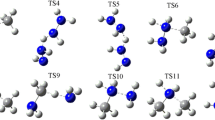Summary
The oxidation of 2,2-Diacyl-1-arylhydrazines1a–l with the system Pb(OAc)4-CF3COOH-CH2Cl2 led to the formation of two types of radical products. Phenazinium cation radicals5a–h were formed from 2,2-diacyl-1-arylhydrazines1a–h, while hydrazyl radicals2i–l were observed to be the only radical products of the oxidation of1i–l. The generated radicals are characterized by their EPR parameters.
Zusammenfassung
Die Oxidation der 2,2-Diacyl-1-arylhydrazine1a–l mit dem System Pb(OAc)4-CF3COOH-CH2Cl2 führte zu zwei unterschiedlichen Typen von Radikalen. Aus den 2,2-Diacyl-1-arylhydrazinen1a–h werden die Phenaziniumkationenradikale5a–h gebildet, während nach Oxidation von1i–l die entsprechenden Hydrazyle2i–l als einzige Radikalprodukte nachweisbar waren. Die erzeugten Radikale wurden durch ihre EPR-Parameter charakterisiert.
Similar content being viewed by others
References
Schulz M., Kluge R., Willscher S. (1987) Liebigs Ann. Chem. 671
Omelka L., Reinhardt M., Kluge R., Schulz M. (1988) Collect. Czech. Chem. Commun.53: 243
Kluge R., Merten O., Nüchter M., Omelka L., Schulz M. (1988) Z. Chem.28: 285
Neugebauer F. A., Bamberger S., Groh W. R. (1975) Chem. Ber.108: 2406
Scheffler K., Stegmann H. B. (1970) Elektronenspinresonanz. Springer, Berlin Heidelberg New York, pp. 317–321
Landolt-Börnstein, New Series, Vol. 9. Magnetic properties of free radicals, part c1. Springer, Berlin Heidelberg New York (1979)
Cauquis G., Delhomme M., Serve D. (1971) Tetrahedron Lett. 4649
Cauquis G., Delhomme M., Serve D. (1975) Electrochim. Acta20: 1019
Cheng J. D., Shine H. J. (1975) J. Org. Chem.40: 703
The ɛ- values were calculated only from independent measurements of the radical concentration by EPR spectroscopy and titration with hydroquinone (20–25% radical yield). Attempts to isolate the corresponding intermediary phenazine were unsuccessful because the reaction mixture was composed of more than 10 products (HPLC) which could not be separated.
Clark-Lewis J. W., Moody K. (1971) Austr. J. Chem.24: 2593
Yamauchi J., Nishiguchi H., Mukai K., Deguchi J., Takaki H. (1967) Bull. Chem. Soc. Japan40: 2512
The hydrazoxyl radical41(g=2.0057) can be prepared by the oxidation of1l with t-BuO ·2 radicals generated by the decomposition of t-BuOOH with PbO2. EPR parameters in mT (a NON =1.302, aN=0.194, a 0H =0.160, a mH =0.095 (1H), a mH =0.058 (1H)) document ortho effect of the tert-butyl group also in this case, especially when compared with EPR data of other hydrazoxyls4 [2].
Author information
Authors and Affiliations
Rights and permissions
About this article
Cite this article
Omelka, L., Kluge, R. & Schulz, M. Radical products of the oxidation of 2,2-diacyl-1-arylhydrazines with the system Pb(OAc)4-CF3COOH-CH2Cl2 . Monatsh Chem 126, 155–161 (1995). https://doi.org/10.1007/BF00812244
Received:
Accepted:
Issue Date:
DOI: https://doi.org/10.1007/BF00812244




